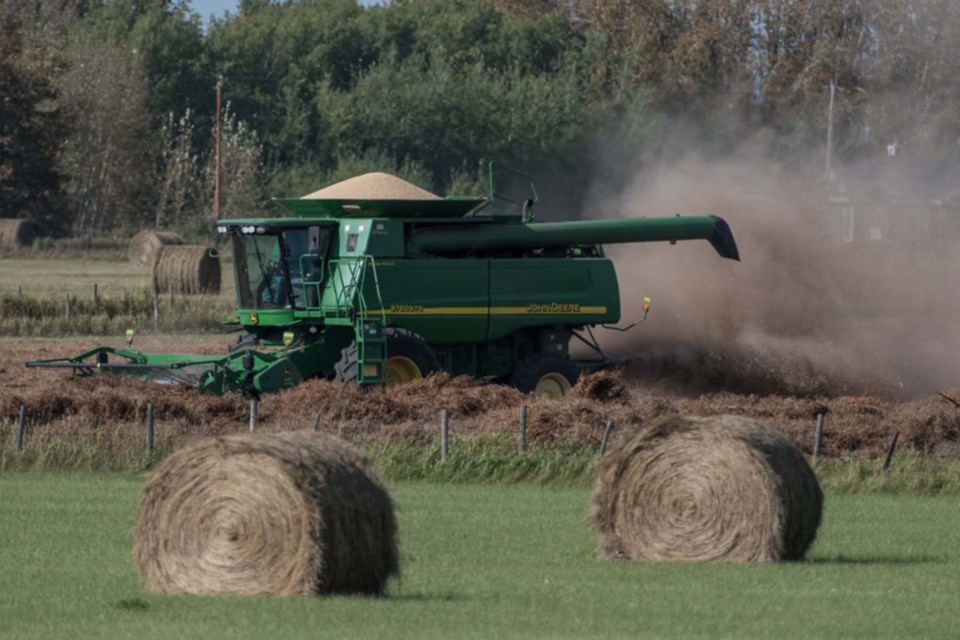Agriculture groups continue to advocate against the fertilizer reduction cap suggested by the federal government earlier this year and have released recommendations with solutions to help continue to produce food while reducing fertilizer use.
Last week the Grain Growers of Canada released its recommendations to the federal government on reducing fertilizer use in agriculture. Andre Harpe, chair of the organization and a farmer in Peace Country, said a 30-per-cent cut in emissions would result in a reduction in food production.
“There is absolutely no way that we can increase food production while at the same time reducing the food that our crops need to grow properly,” Harpe said.
The Grain Growers of Canada represents more than 65,000 grain, pulse, and oilseed farmers from across the country.
Earlier this year the federal government released its new climate change plan, which included a 30-per-cent reduction in fertilizer use in the agriculture sector from 2008 rates by 2030.
Nitrogen fertilizer is considered a contributor to greenhouse-gas emissions.
Harpe said farmers are on the front lines of battling climate change, and see the impacts of it unfolding in their day-to-day lives.
“We deal with climate change every day,” Harpe said.
Last year when the province was suffering from a drought, Harpe said that came out of the pockets of farmers and their bank accounts are directly impacted by climate change.
“We're very much on the front line,” Harpe said.
The Grain Growers recommend the government target reduction in intensity relative to production, rather than absolute reduction, and they want to address data gaps to ensure the baseline reflects usage patterns and accurately measures emissions. They also want to incorporate existing best management practices, such as 4R Nutrient Stewardship, into the National Inventory Report.
Since the initial climate report mandating the change, the federal government has gone from wanting a 30-per-cent reduction in fertilizer use, to a 30-per-cent reduction in fertilizer emissions
The federal government is now saying the reductions are going to be voluntary and won’t be mandated, said Branden Leslie, manager of policy and government relations for Grain Growers of Canada.
“In credit to Minister [of Agriculture and Agri-Food in Canada, Marie-Claude] Bebo, she has been quite adamant that this is meant to be a voluntary target, and they're not intending for a regulatory approach,” Leslie said.
“We'll take the minister at her word, but I think that there was quite a time frame in there, which really left it hanging as to as to how this was actually going to happen.”
Fertilizer reduction can be achieved through a voluntary approach, Leslie said, through nutrient stewardship and application principles, but adopting new technology is an expensive cost for farmers to bear on their own.
“It becomes challenging as to how farmers can afford these new practices," Leslie said.
To help producers reduce their fertilizer use they will need to use new technology, such as slow-release nitrogen, which releases nitrogen when the plant needs it. GPS technology can also be used to deliver nitrogen to plants to ensure areas aren’t getting hit twice with fertilizer.
“These are great advancements and ultimately reduce emissions and do save farmers money, and that's why farmers are certainly willing to invest in these new pieces of equipment, but they just come at a very, very high price tag,” Leslie said.
Funding from the federal government to help farmers integrate these new technologies would help reduce fertilizer use in the fields.
Leslie said the way fertilizer use is measured needs to be re-calibrated, as it is just a calculation of how much fertilizer is sold combined with the amount of rainfall in a region. But that is not an accurate measure of emissions, Leslie said.
“There are data gaps and data challenges with accurate measurements that make this all the more difficult, both in terms of the government's objectives, and just you know, farmers being able to identify the processes that they've undertaken to already reduce emissions,” Leslie said.
Federal-provincial meeting
The issue of nitrogen fertilizer emissions reduction came up during a three-day meeting between the federal, provincial, and territorial ministers earlier this summer and Alberta Minister of Agriculture and Forestry Nate Horner said the provinces brought up the issue to the federal government because of their concerns.
Horner said what Alberta hears most about food is the importance of affordability and food security — the world wants the country to produce more agricultural commodities.
“The federal government obviously has a lot of ambition around emission reduction," Horner said. "But until they speak back to us about achieving emission reductions while increasing production … I think they are being completely disingenuous to the needs and wants of Canadians and the world."
Looking at emissions per unit of production — as opposed to a hard cap measured from previous years — is what Horner would like to see the federal government focus on.


-jf-c.jpg;w=120;h=80;mode=crop)

